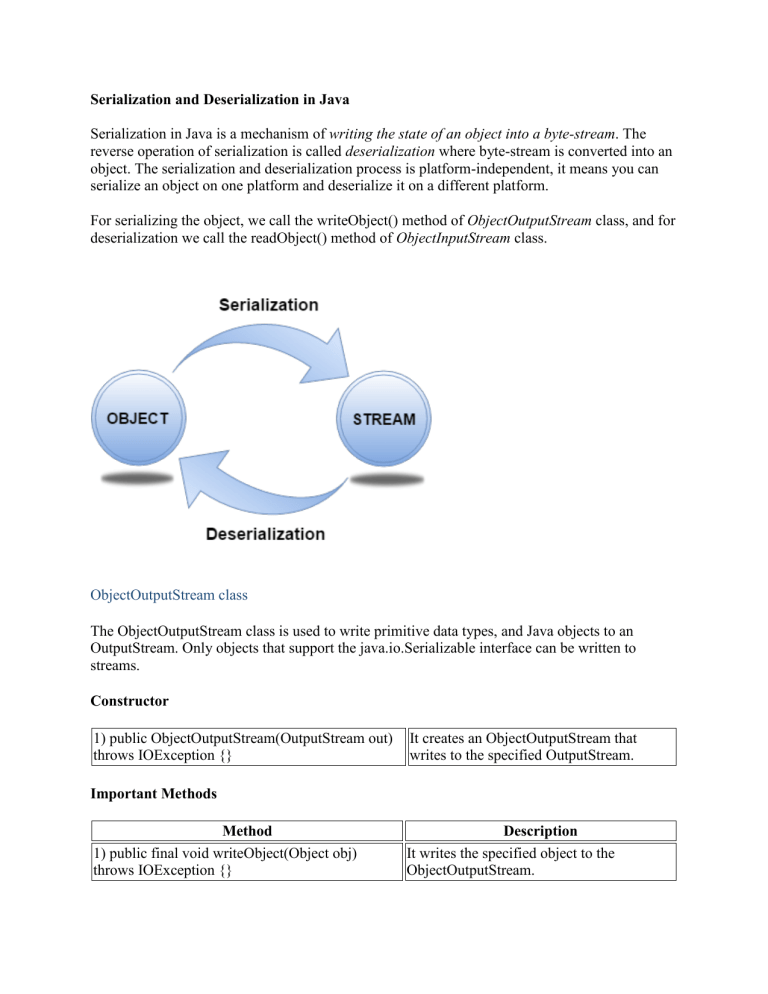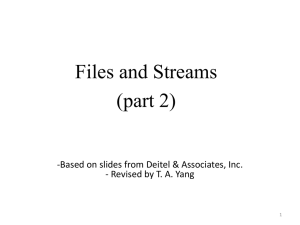
Serialization and Deserialization in Java
Serialization in Java is a mechanism of writing the state of an object into a byte-stream. The
reverse operation of serialization is called deserialization where byte-stream is converted into an
object. The serialization and deserialization process is platform-independent, it means you can
serialize an object on one platform and deserialize it on a different platform.
For serializing the object, we call the writeObject() method of ObjectOutputStream class, and for
deserialization we call the readObject() method of ObjectInputStream class.
ObjectOutputStream class
The ObjectOutputStream class is used to write primitive data types, and Java objects to an
OutputStream. Only objects that support the java.io.Serializable interface can be written to
streams.
Constructor
1) public ObjectOutputStream(OutputStream out)
throws IOException {}
It creates an ObjectOutputStream that
writes to the specified OutputStream.
Important Methods
Method
1) public final void writeObject(Object obj)
throws IOException {}
Description
It writes the specified object to the
ObjectOutputStream.
2) public void flush() throws IOException {}
3) public void close() throws IOException {}
It flushes the current output stream.
It closes the current output stream.
The Serializable interface must be implemented by the class whose object needs to be persisted.
Student class example given below implements the Serializable interface.
Persist.java
import java.io.*;
class Student implements Serializable{
int id;
String name;
Student(int id, String name) {
this.id = id;
this.name = name;
}
}
public class Persist{
public static void main(String args[]){
try{
//Creating the object
Student s1 =new Student(211,"ravi");
//Creating stream and writing the object
FileOutputStream fout=new FileOutputStream("f.txt");
ObjectOutputStream out=new ObjectOutputStream(fout);
out.writeObject(s1);
out.flush();
//closing the stream
out.close();
System.out.println("success");
}catch(Exception e){System.out.println(e);}
}
}
ObjectInputStream class
An ObjectInputStream deserializes objects and primitive data written using an
ObjectOutputStream.
Constructor
1) public ObjectInputStream(InputStream in)
throws IOException {}
It creates an ObjectInputStream that reads
from the specified InputStream.
Important Methods
Method
1) public final Object readObject() throws IOException,
ClassNotFoundException{}
2) public void close() throws IOException {}
Description
It reads an object from the input
stream.
It closes ObjectInputStream.
Example of Java Deserialization
Deserialization is the process of reconstructing the object from the serialized state. It is the
reverse operation of serialization. Let's see an example where we are reading the data from a
deserialized object of the Student class.
Depersist.java
import java.io.*;
class Student implements Serializable{
int id;
String name;
Student(int id, String name) {
this.id = id;
this.name = name;
}
}
public class Depersist{
public static void main(String args[]){
try{
//Creating stream to read the object
ObjectInputStream in=new ObjectInputStream(new FileInputStream("f.txt"));
Student s=(Student)in.readObject();
//printing the data of the serialized object
System.out.println(s.id+" "+s.name);
//closing the stream
in.close();
}catch(Exception e){System.out.println(e);}
}
}




